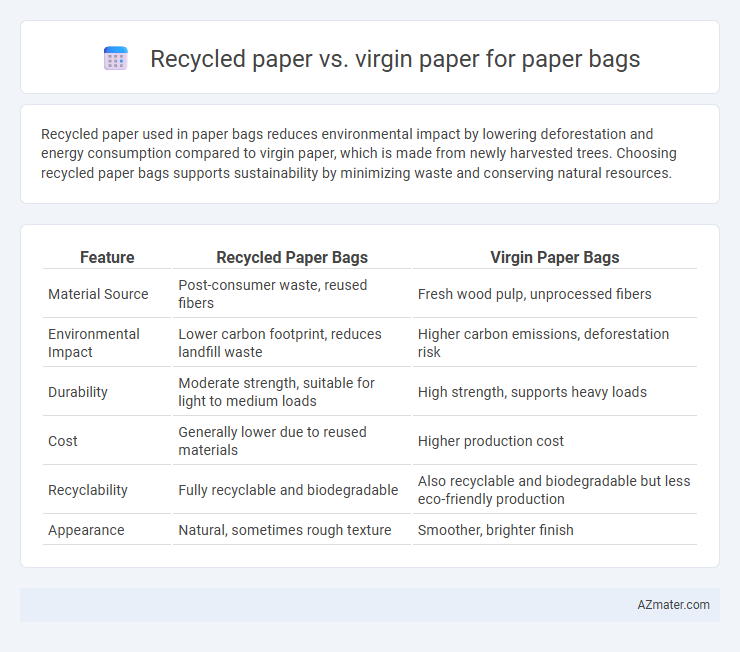Recycled paper used in paper bags reduces environmental impact by lowering deforestation and energy consumption compared to virgin paper, which is made from newly harvested trees. Choosing recycled paper bags supports sustainability by minimizing waste and conserving natural resources.
Table of Comparison
| Feature | Recycled Paper Bags | Virgin Paper Bags |
|---|---|---|
| Material Source | Post-consumer waste, reused fibers | Fresh wood pulp, unprocessed fibers |
| Environmental Impact | Lower carbon footprint, reduces landfill waste | Higher carbon emissions, deforestation risk |
| Durability | Moderate strength, suitable for light to medium loads | High strength, supports heavy loads |
| Cost | Generally lower due to reused materials | Higher production cost |
| Recyclability | Fully recyclable and biodegradable | Also recyclable and biodegradable but less eco-friendly production |
| Appearance | Natural, sometimes rough texture | Smoother, brighter finish |
Introduction: The Importance of Choosing Sustainable Paper
Selecting recycled paper for paper bags significantly reduces deforestation and lowers carbon emissions compared to virgin paper derived directly from trees. Recycled paper uses less water and energy during production, minimizing environmental impact and conserving natural resources. Emphasizing sustainable materials supports circular economy practices and aligns with growing consumer demand for eco-friendly products.
What is Recycled Paper?
Recycled paper is made from used paper products that have been reprocessed to remove contaminants and fibers are repurposed to create new paper materials, reducing the need for virgin wood pulp. This environmentally friendly option lowers deforestation, energy consumption, and greenhouse gas emissions compared to virgin paper, which is derived directly from fresh trees. In the production of paper bags, selecting recycled paper supports sustainability by minimizing waste and conserving natural resources while maintaining functional strength and durability.
Understanding Virgin Paper Production
Virgin paper production for paper bags involves sourcing fresh wood fibers from sustainably managed forests, ensuring strength and durability in the final product. This process includes pulping, bleaching, and refining raw wood to achieve high-quality, uniform paper suitable for heavy-duty use. Compared to recycled paper, virgin paper offers superior strength and moisture resistance but consumes more energy and resources during production.
Environmental Impact of Recycled Paper
Recycled paper used in paper bags significantly reduces deforestation by minimizing the need for virgin wood fibers, conserving natural habitats and biodiversity. The production of recycled paper consumes up to 60% less energy and produces 70% less air pollution compared to virgin paper manufacturing. Utilizing recycled paper in paper bags also decreases landfill waste and lowers greenhouse gas emissions, supporting sustainable waste management and climate change mitigation efforts.
Environmental Consequences of Virgin Paper
Virgin paper production for paper bags relies heavily on deforestation, leading to loss of biodiversity and increased carbon emissions. The process consumes significant amounts of water and energy, contributing to pollution and climate change. Compared to recycled paper, virgin paper generates higher environmental costs due to resource-intensive manufacturing and habitat destruction.
Cost Comparison: Recycled vs Virgin Paper Bags
Recycled paper bags typically cost 10-30% less than virgin paper bags due to lower raw material expenses and reduced energy consumption during production. Virgin paper bags, made from fresh wood pulp, incur higher costs related to deforestation and intensive processing required to achieve pristine fiber quality. Cost-efficiency in recycled paper bags also benefits from lower transportation emissions and waste management savings compared to virgin alternatives.
Strength and Durability: Which Paper Bag Performs Better?
Recycled paper bags often have shorter fiber lengths, resulting in slightly lower strength and durability compared to virgin paper bags made from fresh fibers. Virgin paper bags exhibit superior tensile strength and resistance to tearing, making them more reliable for carrying heavier loads or sharp objects. However, advancements in recycling technology have narrowed this gap, allowing recycled paper bags to perform adequately for most everyday uses while supporting sustainability.
Consumer Perception and Market Demand
Consumer perception favors recycled paper bags for their environmental benefits, influencing a growing market demand driven by eco-conscious buyers and regulatory pressures. Virgin paper bags often appeal due to their perceived strength and quality, but sustainability trends increasingly shift preference toward recycled alternatives. Market data shows brands adopting recycled paper bags to align with green marketing strategies and capture the expanding eco-friendly consumer segment.
Certifications and Standards for Eco-Friendly Paper Bags
Eco-friendly paper bags made from recycled paper often carry certifications such as FSC Recycled, Green Seal, and Blue Angel, ensuring the material meets stringent environmental standards for sustainability and minimal pollution. Virgin paper bags typically hold FSC or PEFC certifications, verifying that the wood pulp is sourced from responsibly managed forests adhering to strict social and environmental standards. Both materials may also comply with ISO 14001 environmental management standards, promoting eco-friendly production practices throughout the paper bag supply chain.
Conclusion: Making an Informed Choice for Paper Bags
Choosing between recycled paper and virgin paper for paper bags involves balancing environmental impact, durability, and cost. Recycled paper significantly reduces deforestation and energy use, making it an eco-friendly option, while virgin paper offers higher strength and longevity essential for heavier loads. Consumers and businesses must evaluate their priorities to select paper bags that best align with sustainability goals and functional needs.

Infographic: Recycled paper vs Virgin paper for Paper bag
 azmater.com
azmater.com